中国黄土高原地处北半球中高纬(33°41′~41°16′N,100°52′~114°33′E),黄土-古土壤序列分布广泛,沉积连续,提供了晚新生代以来东亚地区植被和气候变化的长时间尺度的连续记录[1]。重建黄土高原古植被、古气候演化历史不仅对探讨东亚季风起源、青藏高原隆升[2~6]等重大科学问题起到至关重要的作用,也可以更好地认识气候变化机制[7~8],对全球变暖背景下未来气候的变化趋势具有重要启示意义。
黄土高原地区全新世以来重建植被演化的研究有较多的孢粉记录[9~11],但更长时间尺度的黄土-古土壤序列的孢粉记录却很少[12~13]。随着质谱等测试手段的发展,碳同位素技术逐渐成为黄土高原地区古植被重建的主要研究方法。根据植被不同的光合作用途径,研究区主要植被类型分为C3植物(光合作用采用Calvin-Benson循环,初级产物为三碳化合物:3-磷酸甘油酸)和C4植物(Hatch-Slack循环,初级产物为四碳化合物:草酰乙酸)[14]。C3、C4植物具有不同的动力学分馏过程,从而两者具有不同的碳同位素组成(δ13C)[15]。全球范围内,C3植被δ13C变化区间为-37 ‰ ~-20 ‰,平均值为-28.7 ‰ [16];C4植被δ13C变化区间为-15 ‰ ~-9 ‰,平均值为-13 ‰ [17]。沉积物中与植物体有直接或间接联系的载体,如土壤总有机碳[4, 18]、次生碳酸盐[2, 4, 19]、正构烷烃[20]或黑碳[21~23]的稳定碳同位素变化可被用于重建植被的空间分布或时间演化;同时,植被类型又与当地的气候环境因素,如温度、降水或大气CO2浓度等密切相关[24~25],因此可以通过重建的古植被信息进一步推断同期的古环境信息。
20世纪80年代末,稳定碳同位素开始应用于中国黄土高原沉积剖面的古植被、古气候重建领域[26]。近30年来,随着仪器的精进、指标的丰富,大量相关数据及理论不断呈现[4, 27~29],但在部分研究中,相同剖面不同指标或不同剖面同一指标的研究结果及其指示意义仍存在矛盾,简单重复已有实验流程或粗线条地定性解释并不能解决该领域科学问题的需求,如何更深入地探讨替代性指标的机理及准确性、不同指标间的异同及内在联系成为该领域研究实现突破的关键。本文试图以不同介质的稳定碳同位素指标为分类基础,汇总新生代以来中国黄土高原前人研究的典型剖面数据(剖面位置分布如图 1,引用信息[2, 4, 7, 28, 30~44]汇总见表 1),为深入讨论植被变化和夏季风强弱的关系,本文以地理位置并结合现代年均降水、年均温为分类标准共收集了总有机碳碳同位素(Total Organic Carbon,简称δ13CTOC)剖面22个,空间上,黄土高原东南部6个(蓝田剖面有2组数据)、中部8个和西部8个;时间上,百万年尺度的剖面3个,分别为蓝田、洛川和玉山剖面,较短时间尺度的19个(除灵台[30]为450ka,旬邑[31]为140ka以来,其余均为100ka以来)。同时,为对比10Ma以来C4植物在黄土高原的扩张共汇总6组次生碳酸盐碳同位素(Pedogenic Carbonate,简称δ13CPC)数据,分别为灵台[2]、灵台 *[4]、蓝田[32]、蓝田 *[4]、兰州[33]和白水[34];正构烷烃单体碳同位素(δ13Cn-alkanes)和黑碳碳同位素(Black Carbon,简称δ13CBC)为说明特殊的数据规律仅选取代表性剖面分别为3个(旬邑[28]、洛川[28]和渭南[35])和2个(杨凌[36]和李家塬[36])(见表 1)。本文对比了相同指标或不同指标数据的异同,并侧重总结近几年稳定碳同位素在中国黄土高原古植被、古气候领域的研究进展。
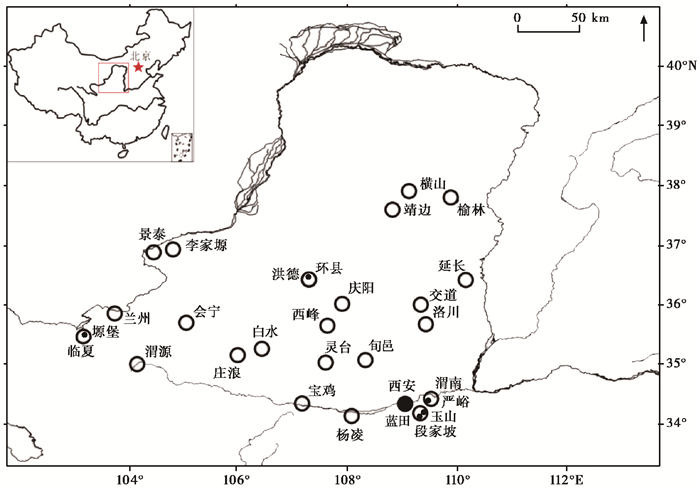
|
图 1 本文引用的典型黄土剖面位置分布图 图中黑色圆圈与圆点均代表本文引用数据的剖面,其中剖面位置相近或同一剖面但命名不同的以小圆点表示 Fig. 1 Locations of typical loess-paleosol profiles that referred in this article. The black circles and dots in the figure represent the cross-sections of the data cited in this article, which are distinguished by dot due to repetition |
| 表 1 本文引用的黄土高原碳同位素数据的沉积剖面信息汇总表 Table 1 Summary of the Chinese Loess Plateau profiles cited in this article with δ13C data |
表生植被死亡分解后,在原地埋藏的情况下,其残余物质的混合体是土壤沉积物中有机质的主要来源[45],即土壤总有机碳直接继承了植被的δ13C信号[46~47]。根据C3、C4植被对应的δ13C变化区间不同,可将黄土-古土壤沉积中δ13CTOC记录用于重建当地古植被信息[17]。鉴于黄土风成沉积的特征,确定黄土-古土壤中有机质的主要来源为地表植被而非外部物源是利用δ13CTOC记录的首要条件[48]。早期研究认为,在植被覆盖相对稀疏的干旱地区,如兰州和西宁,土壤中δ13CTOC主要受控于风尘物源,当地植被的贡献量是非常有限的,因此δ13CTOC指标在使用时要充分考虑背景值的影响[48]。后来通过对黄土高原西部多个表土和典型剖面,以及研究区的粉尘源区等多个地区样品有机质的对比分析,结果显示其主要物源为当地植被,来自外源粉尘携带的TOC含量不超过8 %,对δ13CTOC数值的影响不超过1.7 ‰,所以至少在黄土高原西部地区利用δ13CTOC反演当地古植被信息是可靠的[49]。与此同时,利用高温裂解-色谱-同位素比值的方法也发现黄土中多聚体的裂解产物主要为C9~C17的正构烯烃,说明植物角质和软木脂是不可溶有机质的主要来源,并结合西峰剖面40ka以来的裂解结果推断植物的地下部分是中国黄土高原古土壤有机质的主要来源[50]。
中国黄土高原地区现代植被δ13C和表土δ13CTOC等现代过程的研究是论证δ13CTOC作为古植被、古气候重建指标可靠性的重要方式[4, 31, 51]。刘卫国等[31]于2002年首次对中国黄土高原地区现生植被与现代土壤δ13CTOC组成特征之间的关系展开大规模研究。从整体来看,来自黄土高原从南到北29个区域的现代土壤样品的δ13CTOC与C4植被生物量和生长季降水之间呈现出较高的相关性[4]。从区域角度,黄土高原年均降水等值线300~700mm间的土壤和现代植物样品显示C4生物量与年均降水和5~10月平均气温成正相关[52]。
在重建古植被演化方面,主要集中在不同时间尺度C3/C4植被的时空变化及其对气候的响应。短时间尺度上,末次冰盛期到全新世C4植被发生普遍扩张已成为共识[7, 36, 53~54]。Yang等[7]根据黄土高原21个剖面的δ13CTOC记录发现,C4植被比例在末次冰盛期-全新世整体同步增加约15 %,其重建的C3/C4植被空间模式与现代暖季降水等值线分布十分相似,因此C3/C4植被在末次冰盛期和全新世中期的空间分布格局被认为可代表当时的东亚夏季风降水带。在轨道时间尺度上,刘卫国等[31, 40]发现末次间冰期(约130ka)以来,即使是在十分温暖湿润、理论上更适宜C3乔木生长的间冰期,旬邑、蓝田、洛川地区却从未存在广布的森林覆盖,反而C4草本显著增多,这可能是由于黄土地层孔隙度相对较高,不易储水,不利于C3森林植被的生长。位于黄土高原中部的灵台剖面(450ka以来)[30]和黄土高原东部的交道剖面(620ka以来)[39]的δ13CTOC记录也显示类似结果,间冰期δ13CTOC较冰期偏正,C3、C4植被混生但无大面积森林。在百万年的时间尺度上,玉山剖面在1.5~1.1Ma的δ13CTOC无明显的间冰期偏正、冰期偏负的特征[41]。且不同剖面对应C4植被扩张时间略有差异,如严峪地区在约1.6Ma[42],而蓝田地区在2.9~2.7Ma、1.3~0.9Ma[4]的C4植物明显增多。
在对气候的响应方面,目前的研究主要探讨了δ13CTOC与东亚夏季风强度、温度或湿度的关系。段家坡、塬堡剖面δ13CTOC和磁化率曲线变化趋势大体一致被认为是二者对相同气候环境具有相似的响应,因此δ13CTOC至少可作为黄土高原塬面或半干旱区域古植被和夏季风变化的替代性指标[45, 55]。洛川剖面的δ13CTOC和磁化率在冰期-间冰期尺度上的变化一致则被认为δ13CTOC可以在冰期-间冰期尺度较好地指示夏季风的强弱[37]。Liu等[44]也通过综合黄土高原从北到南5个剖面(环县、西峰、旬邑、渭南和蓝田)35ka以来的δ13CTOC、磁化率以及剖面现代温度和降水数据认为C3/C4比值与高温和夏季降水(即夏季风增强)成正相关。但是玉山剖面的数据显示,在磁化率低于70×10-8m3/kg时,δ13CTOC与磁化率成负相关;在磁化率高于70×10-8m3/kg时,δ13CTOC与磁化率成正相关,因此不可简单地将δ13CTOC作为亚洲夏季风强度指标且只有当季风强度超过某个“阈值”时,C4植被才在当地植被中占据重要比例,此时δ13CTOC才能较好地反映C3/C4植物变化[41]。为更深入和准确地探讨黄土高原地区δ13CTOC对气候的响应,特别是夏季风强度,本文汇总了黄土高原地区22个剖面约2500个样品的δ13CTOC与磁化率数据(见表 1),并根据相对地理位置及年均降水等气候条件分类,从时间空间角度进行相关性讨论。
首先,在黄土高原东南部,现代年均降水600~700mm,年均温10~13℃的剖面具有如下特征(图 2):研究表明在较短时间尺度内(约100ka以来,黄土-古土壤剖面有机质降解到稳定的时间为100ka左右[56],故以100ka为界绘图),δ13CTOC与磁化率具有较好的正相关关系,表明该环境条件下δ13CTOC与磁化率对气候的响应较为一致,夏季风强弱可能是驱动植被类型变化主因。但是在百万年尺度上,二者关系较为复杂。如图 2c和2d,与玉山剖面相距约20km的蓝田剖面[4, 40],两地现代年均温度、降水十分接近,虽然蓝田2.6Ma以来的δ13CTOC随磁化率变化的分布非常分散,但在相同的时间段(1.5~1.1Ma)蓝田剖面δ13CTOC与磁化率的相关性与玉山剖面却十分相似,这不仅说明在黄土高原东南缘地区,当季风强度较低时,δ13CTOC的变化不一定代表C4植被扩张,同时也证明了不同的年代尺度上δ13CTOC对植被类型变化的重建规律是有差异的。
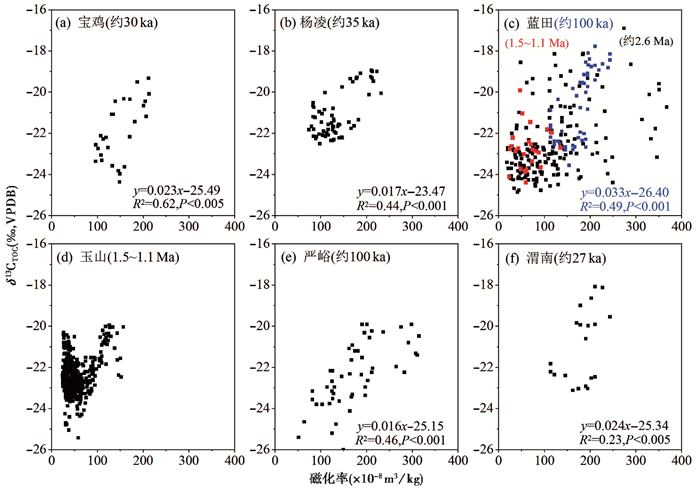
|
图 2 黄土高原东南部典型剖面δ13CTOC与磁化率相关性 图中数据分别引自(a)宝鸡[7]、(b)杨凌[36]、(c)蓝田[4, 40]、(d)玉山[41]、(e)严峪[42]、(f)渭南[44] Fig. 2 δ13CTOC and magnetic susceptibility of typical profiles in the southeast of the Chinese Loess Plateau. The source of the cited data as follows: (a)Baoji[7], (b)Yangling[36], (c)Lantian[4, 40], (d)Yushan[41], (e)Yanyu[42]and (f) Weinan[44] |
在黄土高原中部区,现代年均降水500~600mm,年均温8~10℃范围内的剖面δ13CTOC与磁化率呈现出更为复杂的关系(图 3)。首先,在约100ka以来,δ13CTOC与磁化率的正相关性比上述黄土高原东南部剖面弱,以渭源和西峰剖面为例(图 3a和3d),渭源地区S0层磁化率比L1层增大约100×10-8m3/kg,但δ13CTOC的波动区间几乎没有变化[7];而在西峰地区,相同时段具有类似磁化率的增幅,但δ13CTOC平均值正偏约2 ‰ [44]。另外,在百万年尺度上,洛川剖面的δ13CTOC虽然整体分布(图 3f)与蓝田相似,但δ13CTOC在1.5~1.1Ma的变化趋势与蓝田、玉山大相径庭,这也充分说明在不同区域植被和磁化率对夏季风的响应是存在较大差异的。
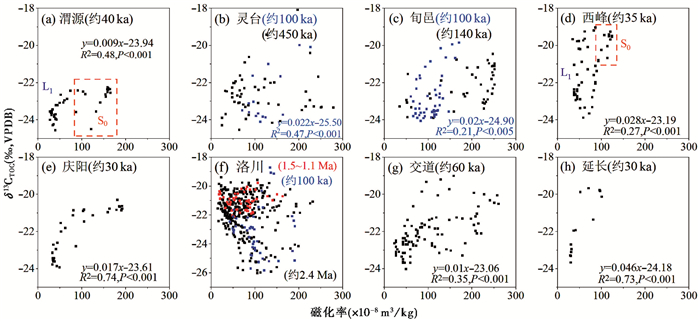
|
图 3 黄土高原中部典型剖面δ13CTOC与磁化率相关性 图中数据分别引自(a)渭源、(e)庆阳和(h)延长[7]、(b)灵台[30]、(c)旬邑[31]、(d)西峰[44]、(f)洛川[37~38]、(g)交道[39] Fig. 3 δ13CTOC and magnetic susceptibility of typical profiles in the center of the Chinese Loess Plateau. The source of the cited data as follows: (a) Weiyuan, (e)Qingyang and (h) Yanchang[7], (b)Lingtai[30], (c)Xunyi[31], (d)Xifeng[44], (f)Luochuan[37~38]and (g) Jiaodao[39] |
在黄土高原西部区现代年均降水400~500mm,年均温6~10℃范围内(图 4),除塬堡外,末次间冰期以来的δ13CTOC与磁化率呈现出强烈的正相关(R2>0.7,p < 0.001),指示了在现代季风区-非季风区分界附近的研究区(如临夏、横山、靖边、榆林),植被类型对季风强度变化的响应十分敏感,未来也许可以对此区域剖面做系统研究,从时间序列上重建古季风区和非季风区的分界演化。与此同时,塬堡(图 4b)和玉山剖面(图 2d)在黄土层(冰期) δ13CTOC的变化范围都很大(最大跨度约为6 ‰),一方面可能是由于在相对冷干的气候条件下,C3植被为主,而不同种类C3植被δ13C本就存在较大的变化范围(-37 ‰ ~-20 ‰)[57];另一方面,在相对干冷的冰期内部,降水减少也可能会导致同一种C3植被出现δ13C正偏的情形[16, 58],因此要充分关注低磁化率值时(主要为冰期)δ13CTOC发生变化的主导因素,而不是直接解释为C3和C4植被类型的改变[41]。在半干旱和干旱地区,年降水量低于400mm的会宁和景泰剖面由于样品量较少,很难得出可靠的统计规律,会宁虽然在季风区的边缘,对古季风气候变化有良好的敏感性,但由于年均温较低,降水较少(6.49℃,370mm)[59],不利于C4植被生长,因此δ13CTOC正偏不一定代表C4植被比例增加,即δ13CTOC与磁化率没有呈现出的较好相关性。
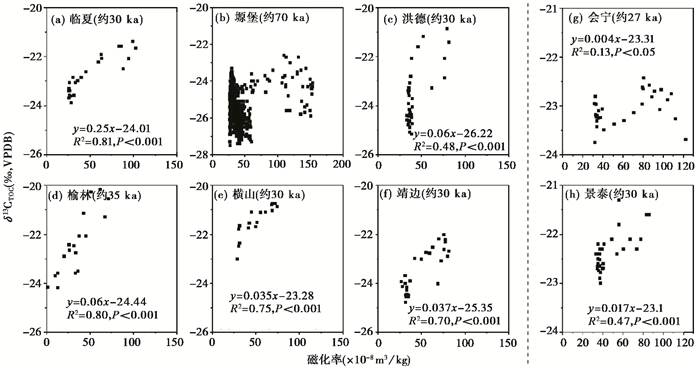
|
图 4 黄土高原西部典型剖面δ13CTOC与磁化率相关性 虚线左边剖面均位于半湿润地区,现代年均降水400~500mm,年均温6~10℃,包括:(a)临夏、(c)洪德、(d)榆林、(e)横山和(f)靖边[7]、(b)塬堡[43];虚线右边剖面位于干旱和半干旱地区:(g)会宁[7]现代年均降水300~400mm,年均温7~8℃;(h)景泰[7]现代年均降水 < 200mm,年均温8~9℃ Fig. 4 δ13CTOC and magnetic susceptibility of typical profiles in the wast of the Chinese Loess Plateau. In the figure, profiles on the left side of dotted line are all located in the semi-humid areas: (a)Linxia, (c)Hongde, (d)Yulin, (e)Hengshan, (f)Jingbian[7]and (b)Yuanbao[43]are located in the Loess Plateau with modern average annual precipitation of 400~500mm and average annual temperature of 6~10℃; Profiles on the right side of the dotted line are located in the semi-arid and arid areas: (g)Modern average annual precipitation is 300~400mm and average annual temperature is 7~8℃ at Huining[7]; (h)Modern average annual precipitation is less 200mm, and average annual temperature is 8~9℃ at Jingtai[7] |
综上,δ13CTOC在100ka以来和磁化率呈现较好的正相关,其中现代季风-非季风区分界附近二者高度相关,这也佐证了夏季风强度对植被类型变化的驱动[44]。同一剖面的δ13CTOC在百万年的时间尺度上整体与磁化率不具有相关性,但是,某一时间段也可能呈现特殊的相关性,比如1.5~1.1Ma期间,黄土高原东南缘的蓝田和玉山剖面在磁化率值较低时,δ13CTOC和磁化率具有高度相同的负相关,这也启示除了区域差异外,未来也应关注不同时间尺度上δ13CTOC、植被类型变化与气候变化的关系。
此外,δ13CTOC指标在应用的过程中还存在较多不确定性,如重建C3/C4植被比例方程参数的多变[17, 39, 60]、区域内部植被演化的复杂性[61]、δ13CTOC的降解[56, 62]等。重建方程使用的C3、C4植被端元值在世界和区域有不同取值,如-27 ‰和-13 ‰ [39]、-24 ‰和-14 ‰ [63]、-26.7 ‰和-12.8 ‰ [17]等;有机碳与植被分馏的修正系数有不同取值,如2.2 ‰、1.0 ‰等[31, 64],以及工业革命前后大气CO2碳同位素修正系数[17]等均需要更精确的研究。与此同时,虽然生物过程所产生的δ13CCO2组成与δ13CTOC基本相同,但是能否完全忽略土壤中由动物和微生物产生的有机质含量带来的影响,还有待进一步定量化讨论[60]。在区域内部因素的复杂性方面,黄土高原西部地区多个剖面显示即使在区域内部,全新世时期δ13CTOC变化趋势也存在差异,如张家川(先正偏后负偏)、红咀寺(短时间正偏)、靖远(负偏)即局域C4植被演化的复杂性仍需要进一步研究[61]。有研究认为,黄土和土壤层的总有机碳及其各组分均随埋藏时间的增加而逐渐降低,黄土可能在L2达到稳定(127~185ka),古土壤层约为S3 (272~330ka)[56],这也与图 2、3、4呈现出100ka以来绝大部分剖面δ13CTOC与磁化率的相关性较好的特征一致。黄河中游地区黄土和土壤沉积数据则表明埋藏过程中有机质的损失主要发生在S8以前(约800ka)[62]。因此,由于有机碳分解带来的碳同位素分馏也应当被充分研究和修正。
2 次生碳酸盐的稳定碳同位素δ13CPC作为古气候、古生态反演指标最早是由Cerling[19]于1984年提出,δ13CPC取决于土壤孔隙中CO2的碳同位素,后者又由两部分构成:土壤呼吸成因CO2和大气CO2,在高土壤生产力条件下,植物根系呼吸作用或微生物氧化作用产生的CO2分压远大于大气CO2分压,此时C4植被比例是决定δ13CPC的主导因素。又因在不同的气候条件下,C4植被在总植被生物量中的占比不同[14],所以在古土壤次生碳酸盐未发生蚀变的情况下,δ13CPC可反映其生长期的古植被、古气候信息。
1987年,Zheng等[26]以洛川黄土剖面为例,探讨了钙结核中碳同位素作为古气候指标的可能性,以此拉开了δ13CPC用于研究中国黄土高原沉积剖面古植被、古气候的序幕。其后,灵台[2]、蓝田[32, 38]、西峰[65]、渭南[65]、严峪[42]、庄浪[66]、白水[34]、宝鸡[67]、洛川[68]等典型的黄土沉积剖面也进行了不同时间尺度的分析测试,主要讨论的科学问题集中在碳酸盐的分类与重建准确度、C4植被演化历史及其驱动因素等方面。
在碳酸盐类别与重建准确度方面,由于黄土剖面为风成沉积,黄土-古土壤中原生碳酸盐和次生碳酸盐共存,分别反映的是黄土物源信息和矿物生长期的气候信息[69~71]。韩家懋等[65]通过比较了西峰、洛川和渭南黄土剖面的全岩碳酸盐和次生碳酸盐的δ13C,认为二者均较好地反映了古气候变化,但作者并未在同一剖面进行对照试验以及并未探讨原生碳酸盐对全岩样品影响程度等问题;盛雪芬等[72]将不同粒级的黄土-古土壤样品中的根状结核、蜗牛壳和全岩碳酸盐的δ13C进行对比,结果显示 < 2μm样品中三者数据十分相似,即粒级 < 2μm的黄土-古土壤样品的全岩碳酸盐可代表次生碳酸盐,进而用于重建古植被、古气候信息;Sun等[8]根据靖远剖面1.7Ma以来的全岩碳酸盐δ13C记录揭示了新的中更新世气候转型的变化周期,以及轨道强迫、冰盖及大气CO2浓度对温度和降水的调控存在区域性差异;Da等[38]借助扫描电镜及微量元素比值(如Mn、Mg和Sr)辅证了细颗粒微米-纳米级针簇状方解石的次生来源并用于指示古大气CO2浓度变化。
在恢复C4植被演化历史方面,灵台剖面7.0Ma以来的δ13CPC记录在4.0Ma出现大幅度正偏(图 5a),因此推断黄土高原的C4植物在4.0Ma左右发生扩张[2];后续蓝田剖面的沉积记录显示[32],虽然灵台和蓝田仅相距200km,在纬度上仅相差1°,但4.0Ma扩张事件并未在蓝田剖面δ13CPC记录中得以体现,即使蓝田δ13CPC在4.0Ma前后有正偏的趋势,但δ13CPC数值仍低于-8 ‰,即植被类型仍然为纯C3植被(图 5c,图中垂直虚线δ13CPC=-8 ‰,该研究将δ13CPC=-8 ‰作为纯C3植被与C3-C4混合类型的分界值)。但是,受碎屑碳酸盐、局部植被稀疏以及大气CO2贡献比例等因素的影响,δ13CPC的数值具有区域差异性,统一将-8 ‰和-4 ‰作为纯C3植被、C3-C4混合类型和纯C4植被的分界值似乎并不合理。如图 5e,兰州盆地九州台剖面的样品δ13CPC数值更为偏正,研究认为可能是由碎屑碳酸盐的影响、C4植被扩张或局部植被稀疏造成的[33]。An等[4]结合灵台(图 5b)、蓝田(图 5d)更高分辨率的δ13CPC和δ13CTOC记录认为4.0Ma以来,研究区共有3次C4植物的扩张期,分别为约2.9~2.7Ma、1.3~0.9Ma和0.6Ma至今。
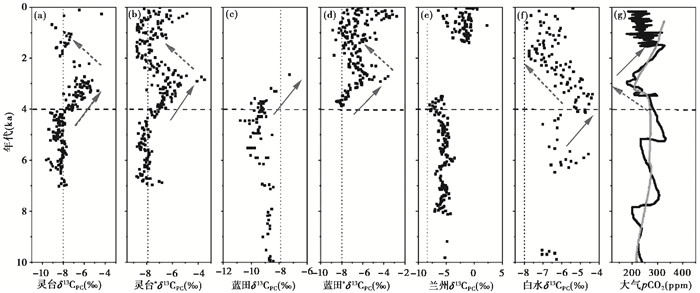
|
图 5 典型黄土-古土壤沉积剖面次生碳酸盐稳定碳同位素及大气pCO2变化曲线对比 依次为(a)灵台剖面[2]、(b)灵台剖面 *[4]、(c)蓝田剖面[32]、(d)蓝田剖面 *[4]、(e)兰州盆地剖面[33]以及(f)白水剖面[34]的次生碳酸盐稳定碳同位素变化曲线;(g)为大气pCO2变化曲线(黑色曲线来源Tripati等[73],灰色曲线来源Pearson等[74]) 水平虚线为4.0Ma,垂直虚线为δ13CPC=-8 ‰ (纯C3植被环境中δ13CPC的变化范围为-14 ‰至-8 ‰,-8 ‰代表纯C3植被与C3-C4混合类型的分界值[32]);实线箭头表示δ13CPC正偏和pCO2增大,虚线箭头表示δ13CPC负偏和pCO2降低 Fig. 5 The variation of the stable carbon isotopes of pedogenic carbonate in different loess-paleosol sedimentary profiles and atmospheric pCO2 records. From (a) to (f), the stable carbon isotope records of pedogenic carbonate from (a) Lingtai[2], (b)Lingtai*[4], (c)Lantian[32], (d)Lantian*[4], (e)Lanzhou Basin[33]and (f) Baishui[34]sections respectively; (g)Variations in pCO2 records(black line[73], gray line[74]). The horizontal dotted line is 4.0Ma, and the vertical dotted line is δ13CPC=-8 ‰. The soil carbonates formed in the presence of pure C3 vegetation are between -14 ‰ and -8 ‰, whereas values above -8 ‰ represent a mixture of C3 and C4 plants[32]. The full line arrows represent δ13CPC records get positive and pCO2 increases and the dotted line arrows represent negative trends |
从变化趋势上看,δ13CPC在黄土高原的变化趋势大致相似,如4.0Ma左右开始的正偏以及2.6Ma左右的负偏,但部分剖面(图 5f,白水剖面)的扩张和衰退时间似乎更早[34]。与此同时,相对于多个剖面δ13CPC指示的4.0Ma左右C4植物的扩张,来自黄土高原中-上新世暖期(3.3~3.0Ma)的δ13CTOC记录却表明,除黄土高原东北缘的佳县有约10 % 的C4植被外,其余地区几乎为纯C3植被[27],灵台地区黑碳记录[22]虽显示4.0Ma燃烧植被中有C4,但也没有大幅扩张的趋势。两组分端元混合模型显示,碳酸盐结晶过程中大量的大气CO2(最多占比60 %)掺入土壤孔隙中[27],结合由多种方法重建的大气pCO2在4.0Ma有大幅下降(图 5g)[73~74],但δ13CCO2无明显变化[75]的特征,δ13CPC在4.0Ma的正偏也许是大气pCO2降低的表征。
δ13CPC在黄土高原地区对C4植被的重建,除了在扩张时间和比例方面存在差异(如图 5),δ13CPC在时空上的变化趋势与δ13CTOC和现代植被δ13C的变化趋势也相反,从而引发了对δ13CPC指标能否直接指示C4植被变化的讨论。从δ13CPC和δ13CTOC指代信息不同的角度,Wang等[76]认为总有机碳和次生碳酸盐的碳源不同,总有机碳会随时间逐渐降解而次生碳酸盐倾向在干燥的生长季形成,因此δ13CTOC反映的是植物生物量的年平均值,而δ13CPC更多反映植物群落季节层面的信息。现代土壤中次生碳酸盐的形成模式表明,C3、C4代谢的峰值具有季节性差异,夏季形成的碳酸盐记录更强的C4植被信号,即δ13CPC偏正;在春、秋季节形成的碳酸盐记录更强的C3植被信号,即δ13CPC偏负[77];也有研究认为,δ13CPC被认为是对植被密度的直接反映,而植被密度受控于亚洲夏季风所带来的降水,C4植被生物量仅为次要因素,因此认为中国黄土或第三纪红粘土中的δ13CPC在重建C4植被的应用中都是不可靠的[78~79]。从分馏角度,CO2与碳酸盐交换平衡时的分馏系数在古土壤和黄土发育时不一致也可导致了δ13CPC与δ13CTOC成相反趋势[80]。从区域差异性角度,在低纬度地区,干旱化增强或相关火活动频率的增加也许是晚中生代C4植被扩张的主因;在中高纬度地区,特别是黄土高原区域,与亚洲夏季风增强相关的暖季降水诱发了C4植被扩张事件[66]。从指标间的对比角度,基于δ13CPC和磁化率的变化趋势与土壤风化强度不一致且二者关系不能直接外推到C4植被比例变化与夏季风的关系等,研究者认为δ13CPC变化及其指示的C3、C4相对生物量变化与夏季风的线性关联推理可能过于简单[34]。从次生碳酸盐形成机理的角度,土壤CO2混合端元模型表明,在黄土高原半干旱、干旱地区,大气CO2在土壤孔隙中的占比最高可达60 %,从而导致由区域干旱为主要驱动的次生碳酸盐更多反映的是大气CO2组成,而非C3/C4植被丰度,这也解释了δ13CPC和δ13CTOC记录解耦的问题[27]。
基于以上数据结果和机理研究,δ13CPC直接用于重建黄土高原地区C4植被信息在一定程度上是不可靠的,更准确地解释δ13CPC指标,比如结合土壤CO2混合端元模型来修正大气CO2组成带来的误差,调整用于重建C4植被比例公式的δ13CPC端元值等[27];以及更好地利用现有数据解决新的科学问题,比如结合δ13CTOC、磁化率等来重建地质历史时期大气CO2浓度[38, 81]、东亚季风强度[82]等可能是δ13CPC指标继续发展的方向。
3 正构烷烃单体碳同位素随着色谱、同位素质谱等检测手段的提升,特定生物标志物单体同位素的分析已经成为获取古植被和古环境信息的重要途径之一[83~87],其中正构烷烃是分子结构最为简单的脂类化合物,其单体碳同位素组成取决于植物体生长所利用碳源的碳同位素及伴随着固碳作用和生物合成作用相关的碳同位素分馏[88]。即使受到地质历史时期的成岩或成壤作用的破坏,其记录生物母质信息的碳骨架仍会基本留存[89],因此δ13Cn-alkanes可用于反映古植被信息。
目前,黄土高原沉积剖面正构烷烃相关的研究主要为δDn-alkanes [90]、平均碳链长度(ACL)、碳优势指数(CPI)等方面[91~93],以δ13Cn-alkanes为主要研究对象的黄土-古土壤剖面并不是很多,时间尺度也相对较短,主要分布在黄土高原中部和东南缘地区[28, 35, 44, 94]。位于黄土高原中部的西峰剖面,其末次间冰期以来正构烷烃nC29、nC31的δ13C与δ13CTOC变化趋势显示出较高的一致性,这也证明了黄土样品δ13CTOC用于重建古植被信息的可靠性[44]。考虑到干旱、pCO2等也会造成C3、C4植被δ13Cn-alkanes的改变,Zhang等[28]在重建旬邑剖面和洛川剖面(图 6a和6b)的C3、C4植被类型时,对δ13Cn-alkanes的加权平均值

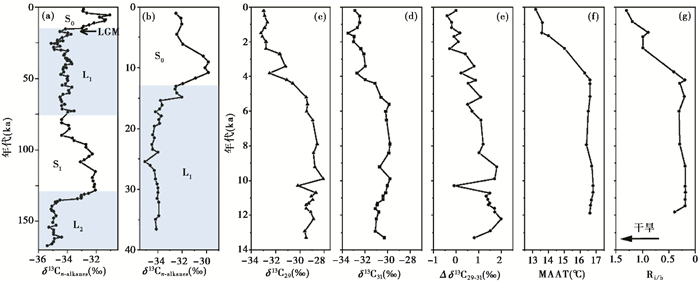
|
图 6 旬邑、洛川及渭南剖面正构烷烃单体碳同位素及古气候对比 (a)、(b)分别代表旬邑、洛川剖面正构烷烃单体碳同位素变化曲线[28];(c)、(d)、(e)分别代表渭南剖面正构烷烃nC29、nC31单体碳同位素及二者之差(Δδ13C29~31)的变化曲线[35];(f)和(g)为渭南剖面的气候指标[95]:MAAT是指年均大气温度,Ri/b是指古菌的类异戊二稀甘油二烷基甘油四醚化合物(Isoprenoid glycerol dialkyl glycerol tetraethers(GDGTs))和细菌的支链甘油二烷基甘油四醚化合物(branched GDGTs)的比值,Ri/b>0.5可指示干旱事件 Fig. 6 δ13Cn-alkanes and paleoclimate records of Xunyi, Luochuan and Weinan sites. Figures (a) and (b)represent the δ13Cn-alkanes at Xunyi and Luochuan sites[28]; Figures (c), (d)and (e) represent δ13C of nC29, nC31 and Δδ13C29~31 at Weinan site[35]. (f)The tetraether-derived mean annual air temperature(MAAT)in the Weinan section[95], (g)Ri/b refers the abundance of isoprenoid glycerol dialkyl glycerol tetraethers(GDGTs)relative to branched GDGTs in the Weinan section and Ri/b>0.5 can be used to indicate drought events[95] |
然而,正构烷烃指标存在林冠效应[96](树冠下部叶片的δ13Cn-alkanes比上部偏负),甚至同种植物在不同生长阶段其δ13Cn-alkanes也会发生变化[97],此外,黄土作为典型的风成堆积,其物质来源的多样性又增加了正构烷烃组成的不确定性,探讨原地埋藏正构烷烃的比例是将δ13Cn-alkanes作为黄土高原地区植被及气候替代指标的前提[98]。与此同时,黄土-古土壤沉积为氧化环境,较湖泊、海洋泥炭等还原环境,正构烷烃更难保存,导致提取较困难也是重要的限制因素之一。因此,黄土高原正构烷烃指标在古生态环境研究中的应用前景还有待探索。
4 黑碳稳定碳同位素黑碳又称元素碳或热解碳,是由有机质或化石燃料的不完全燃烧产生的连续统一体,化学稳定性较高、不易降解[99]。黑碳除了在燃烧过程中存在微小的碳同位素分馏,燃烧后变成一种“死碳”,即不再与外界进行碳交换,所以δ13CBC可代表燃烧物的稳定碳同位素组成[21, 100],被燃烧植被的碳同位素组成又由植被类型、气候环境等共同决定[101],因此δ13CBC可用于反演古植被信息和环境指示意义[102~103]。
在黄土高原地区,研究者们同样比对了现代土壤中δ13CBC与现代植被类型分布特征或与其他替代指标的相关性。例如,贯穿黄土高原的芮城-靖边、蓝田-环县、秦安-定西这3条路线表层土样中的δ13CBC和δ13CTOC具有较高相关性,而且δ13CBC反映的植被类型分布与观察到的表生植被一致[104](图 7a),从而认为表层土壤中δ13CBC是由地表植被决定,随即推演到古土壤中δ13CBC可以有效指示古植被(精确度在±1.5 %)[105]。古土壤中δ13CBC与相应地层孢粉信息的吻合也进一步证明了重建古植被的可靠性[21, 106]。
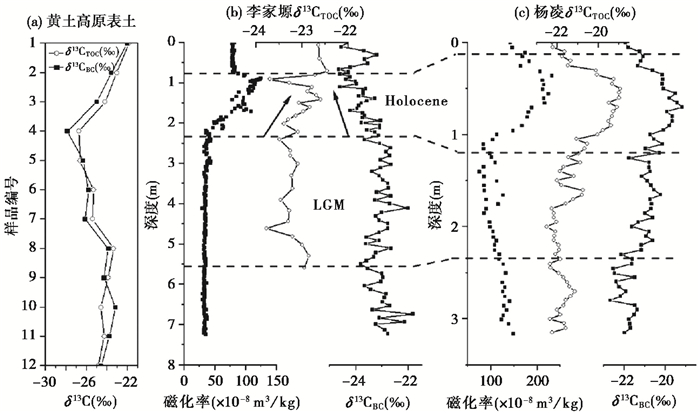
|
图 7 黄土高原表层土[104]及李家塬、杨凌剖面[36]黑碳和土壤有机碳碳同位素 图中从左至右依次为(a)黄土高原地区土壤总有机碳碳同位素(空心圆点线图)及黑碳碳同位素(实心圆点线图);(b)李家塬剖面的磁化率、总有机碳碳同位素及黑碳碳同位素;(c)杨凌剖面磁化率、总有机碳碳同位素及黑碳碳同位素 Fig. 7 A comparison of δ13CBC with δ13CTOC records of topsoil samples from the Chinese Loess Plateau[104]and paleosol samples from Lijiayuan and Yangling[36]. From left to right, (a)δ13CTOC(hollow dotted line)and δ13CBC(solid dotted line)in the Chinese Loess Plateau; (b)The magnetic susceptibility, δ13CTOC and δ13CBC of the Lijiayuan section; (c)The magnetic susceptibility, δ13CTOC and δ13CBC of the Yangling section |
然而,时间序列上的δ13CBC与δ13CTOC部分记录却存在分歧,例如灵台剖面晚第四纪以来的沉积记录显示,虽然δ13CBC能基本反映生长植被的信息,但δ13CBC和δ13CTOC在冰期-间冰期尺度和变化趋势的细节上存在差异[21]。如图 7b和7c,末次冰期以来,杨凌和李家塬剖面磁化率、δ13CTOC和δ13CBC记录的对比结果显示,三者在杨凌剖面的变化趋势一致性较高,而李家塬剖面的δ13CBC和δ13CTOC记录在全新世完全相反[36],该研究认为,由于李家塬地处黄土高原西北部,主要以C3植被为主,在温暖的全新世,周边山体有更多的C3植物被燃烧,导致δ13CBC对燃烧的C4植物信号的捕获能力减弱;而在末次冰盛期,由于火发生季从春天转移到夏天,δ13CBC可能夸大了C4植物的燃烧信号。Liu等[29]分析了西峰剖面L5~S5的δ13CBC和δ13CTOC,认为干旱和低温导致了C3植被δ13C的偏正,δ13CBC记录的正是火季C3植被这种正偏的信号,而δ13CTOC反映的是植被全年的δ13C特征。综上,δ13CTOC记录的是生长植被信息[76]而δ13CBC更多反映的是燃烧植被[99]。在存在较多C3乔木的地区且只发生表面火时,燃烧植被与生长植被差别较大,二者的δ13C必然存在差异;在只有草原植被类型的区域,燃烧植被与生长植被更一致,两者的一致性应较好[101],因此δ13CBC和δ13CTOC的一致性与研究区域及原生植被类型有较大关系。此外,与有机碳主要以原地沉积不同,黑碳可能存在一些远源沉积的细小颗粒[107~109],这增加了δ13CBC来直接指示当地植被的不确定性。
5 综合对比为了更系统和清晰地对比碳同位素不同指标间的差异,结合上文综述和讨论做对比图(图 8),从碳来源和影响因素角度,可以看出总有机碳和正构烷烃的碳来源更为直接[20, 27],二者相比,总有机碳更倾向于代表植被整体平均δ13C,而正构烷烃受到林冠效应、生长周期中δ13C变化等因素的影响需要更细致的讨论[110]。黑碳在本质上是代表被燃烧植被的情况,重建古植被的前提则是燃烧物与生长期植被近似相等,因此对于区域植被类型、火势大小等有一定要求[99~101]。次生碳酸盐在形成过程中同时利用土壤呼吸CO2的大气CO2,前者的δ13C和新鲜土壤有机质的δ13C近似相等,这是重建古植被的理论基础,但大气CO2的占比及其干扰程度必须量化和修正才能提高δ13CPC记录的准确性[19, 27]。外来物源,如碎屑碳酸盐、周边山区(或高地等)发生的特殊火事件对δ13CPC和δ13CBC的影响是极其重要的[36, 72];正构烷烃、黑碳的降解比例很低,但有机质降解产生的同位素分馏必须经过校正[111],由于碳酸盐的季节性沉降、在古土壤和黄土层的平衡分馏系数不同等[76~77, 80],分馏作用带来的影响也是最复杂的,机理类的研究也许是提高重建准确度的关键;植被种属的区域差异带来的重建公式中端元值的差异问题也是普遍存在的,更多现代过程的调查在小区域的应用中也是必不可少的环节。
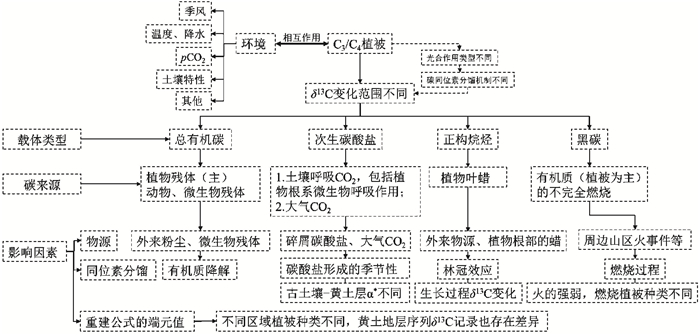
|
图 8 黄土地层序列δ13C记录种类及其影响因素综合对比图 α*代表CO2与碳酸盐之间的平衡分馏系数,土壤呼吸CO2和新鲜土壤有机质的碳同位素近似相等 Fig. 8 Comprehensive comparison of different carbon isotope proxies and factors in the loess profile. α* represents the equilibrium fractionation factor between CO2 and carbonate, and soil respiration CO2 shares similar δ13C values with fresh soil organic matter |
本文从黄土-古土壤地层中4种稳定碳同位素指标的应用原理入手,综述了中国黄土高原地区典型剖面在重建古植被、古气候方面的研究成果及问题。首先,黄土-古土壤作为具有丰富的古植被、古气候相关信息的沉积序列,虽然相对完整且扰动较小,但确定其碳同位素载体是否可反映本地植被变化仍存在一定争议。土壤有机质的主要来源为腐烂后的表生植被,δ13CTOC不会出现碳酸盐矿物形成过程中的分馏作用,因此δ13CTOC对于古植被类型分布和古气候的反演更为直接。本文汇总的22个黄土高原典型剖面的δ13CTOC与磁化率数据发现,首先,δ13CTOC的变化并不一定代表植被类型发生了变化,且在不同区域的相关性差别很大,比如在季风区-非季风区分界区附近,δ13CTOC与磁化率相关性极高,可能该区域暗示植被类型对季风强弱变化的响应十分敏感。在时间上,较短时间尺度上(约100ka)δ13CTOC与磁化率的相关性要远高于百万年的时间尺度,因此要充分考虑长时间尺度上δ13CTOC降解和不同区域对气候响应的差异。次生碳酸盐的碳同位素在用于古植被类型重建时要充分考虑古大气CO2的影响,丰富的δ13CPC记录也许可以用于重建其他气候环境信息(如古大气CO2浓度等)。正构烷烃单体碳同位素是最直接用于反映古植被类型的指标,但由于影响因素复杂以及保存困难等问题,目前黄土沉积剖面数据较少,已有数据显示δ13Cn-alkanes与温度、降水等气候指标的相关性较好。黑碳碳同位素更倾向于反映燃烧植被类型变化,只有在以草本和灌木为主的区域,其与δ13CTOC记录更为一致,可以较为准确地指示生长植被类型的变化。综上,通过稳定碳同位素的分馏理论来应用以上指标反演黄土高原古植被和古气候,但也因为无法定量化碳同位素分馏的控制因素而导致重建的确定性受限。不断优化碳同位素分馏模型,厘清各种控制因素的影响程度可以帮助我们通过不同指标的相互印证来最终更精确地重建黄土高原地区的古植被和古气候信息。
致谢: 感谢审稿专家和编辑部杨美芳老师宝贵的修改意见,达佳伟、鲍睿老师的耐心指导,在此一并感谢!
| [1] |
Williams M, 刘东生, Dunkerley D, 等; 储国强, 刘嘉麒, 韩家懋, 等, 译. 第四纪环境[M]. 北京: 科学出版社, 1997: 198-215. Williams M, Liu Tungsheng, Dunkerley D, et al.; Chu Guoqiang, Liu Jiaqi, Han Jiamao, et al. Trans. Quaternary Environment[M]. Beijing: Science Press, 1997: 198-215. |
| [2] |
Ding Z, Yang S. C3/C4 vegetation evolution over the last 7.0 Myr in the Chinese Loess Plateau: Evidence from pedogenic carbonate δ13C[J]. Palaeogeography, Palaeoclimatology, Palaeoecology, 2000, 160(3-4): 291-299. DOI:10.1016/S0031-0182(00)00076-6 |
| [3] |
An Z, Kutzbach J E, Prell W L, et al. Evolution of Asian monsoon and phased uplift of the Himalaya-Tibetan Plateau since Late Miocene times[J]. Nature, 2001, 411: 62-66. DOI:10.1038/35075035 |
| [4] |
An Z, Huang Y, Liu W, et al. Multiple expansions of C4 plant biomass in East Asia since 7 Ma coupled with strengthened monsoon circulation[J]. Geology, 2005, 33(9): 705-708. DOI:10.1130/G21423.1 |
| [5] |
Guo Z, Ruddiman W F, Hao Q, et al. Onset of Asian desertification by 22 Myr ago inferred from loess deposits in China[J]. Nature, 2002, 416: 159-163. DOI:10.1038/416159a |
| [6] |
庞奖励. 黄土高原黄土稳定同位素与古季风研究进展[J]. 中国沙漠, 1998, 18(3): 83-92. Pang Jiangli. Advances on studies of stable isotope in palaeosol and palaeo-monsoon on the Loess Plateau, China[J]. Journal of Desert Research, 1998, 18(3): 83-92. |
| [7] |
Yang S, Ding Z, Li Y, et al. Warming-induced northwestward migration of the East Asian monsoon rain belt from the Last Glacial Maximum to the mid-Holocene[J]. Proceedings of the National Academy of Sciences of the United States of America, 2015, 112(43): 13178-13183. DOI:10.1073/pnas.1504688112 |
| [8] |
Sun Y, Yin Q, Crucifix M, et al. Diverse manifestations of the mid-Pleistocene climate transition[J]. Nature Communications, 2019, 10(1). DOI:10.1038/s41467-018-08257-9 |
| [9] |
仵慧宁, 张彩霞, 赵海阔, 等. 陇中黄土高原末次冰盛期以来的植被演替及其气候响应[J]. 生态学杂志, 2020, 39(8): 2488-2500. Wu Huining, Zhang Caixia, Zhao Haikuo, et al. Vegetation succession and its response to climate changes since the Last Glacial Maximum on the Loess Plateau of Central Gansu, Northwest China[J]. Chinese Journal of Ecology, 2020, 39(8): 2488-2500. |
| [10] |
杨肖肖. 末次盛冰期以来黄土高原南部与西部的植被和气候变化[D]. 北京: 中国地质大学(北京)硕士学位论文, 2013: 33-53. Yang Xiaoxiao. Vegetation and Climate Changes in the Southern and Western Loess Plateau since Last Glacial Maximum[D]. Beijing: The Master's Thesis of Chinese University of Geosciences (Beijing), 2013: 33-53. |
| [11] |
蔡茂堂, 魏明建. 黄土高原全新世孢粉古植被地方性分异研究[J]. 首都师范大学学报(自然科学版), 2009, 30(4): 48-53. Cai Maotang, Wei Mingjian. The research of Holocene vegetable characteristic of different locations in Loess Plateau[J]. Journal of Capital Normal University (Natural Science Edition), 2009, 30(4): 48-53. DOI:10.3969/j.issn.1004-9398.2009.04.011 |
| [12] |
Wu F, Fang X, Ma Y, et al. Plio-Quaternary stepwise drying of Asia: Evidence from a 3-Ma pollen record from the Chinese Loess Plateau[J]. Earth and Planetary Science Letters, 2007, 257(1-2): 160-169. DOI:10.1016/j.epsl.2007.02.029 |
| [13] |
张立原. 中国黄土高原洛川剖面S5以来的孢粉学记录[J]. 吉林大学学报(地球科学版), 2014, 44(1): 222-229. Zhang Liyuan. Palynological records from the Luochuan section of the Chinese Loess Plateau since S5 stage[J]. Journal of Jilin University(Earth Science Edition), 2014, 44(1): 222-229. |
| [14] |
Raven P H, Event R F, Eichhorn S E. Biology of Plants(6th Ed)[M]. New York: Freeman and Company Worth Publishers, 1999: 1-50.
|
| [15] |
Farquhar G D, Ehleringer J R, Hubick K T. Carbon isotope discrimination and photosynthesis[J]. Annual Review of Plant Physiology and Plant Molecular Biology, 1989, 40(1): 503-537. DOI:10.1146/annurev.pp.40.060189.002443 |
| [16] |
Kohn M J. Carbon isotope compositions of terrestrial C3 plants as indicators of (paleo) ecology and (paleo) climate[J]. Proceedings of the National Academy of Sciences of the United States of America, 2010, 107(46): 19691-19695. DOI:10.1073/pnas.1004933107 |
| [17] |
Wang G, Feng X, Han J, et al. Paleovegetation reconstruction using δ13C of soil organic matter[J]. Biogeosciences, 2008, 5(5): 1325-1337. DOI:10.5194/bg-5-1325-2008 |
| [18] |
Chen F, Rao Z, Zhang J, et al. Variations of organic carbon isotopic composition and its environmental significance during the last glacial on western Chinese Loess Plateau[J]. Chinese Science Bulletin, 2006, 51(13): 1593-1602. DOI:10.1007/s11434-006-2003-6 |
| [19] |
Cerling T E. The stable isotopic composition of modern soil carbonate and its relationship to climate[J]. Earth and Planetary Science Letters, 1984, 71(2): 229-240. DOI:10.1016/0012-821X(84)90089-X |
| [20] |
郑艳红, 程鹏, 周卫健. 正构烷烃及单体碳同位素的古植被与古气候意义[J]. 海洋地质与第四纪地质, 2005, 25(1): 99-104. Zheng Yanhong, Cheng Peng, Zhou Weijian. Paleo-vegetation and paleo-climate n-alkanes and compound-specific carbon isotopic compositions[J]. Marine Geology & Quaternary Geology, 2005, 25(1): 99-104. |
| [21] |
周斌, 沈承德, 郑洪波, 等. 黄土高原中部晚第四纪以来植被演化的元素碳碳同位素记录[J]. 科学通报, 2009, 54(9): 1262-1268. Zhou Bin, Shen Chengde, Zheng Hongbo, et al. Vegetation evolution on the central Chinese Loess Plateau since Late Quaternary evidenced by elemental carbon isotopic composition[J]. Chinese Science Bulletin, 2009, 54(9): 1262-1268. |
| [22] |
Zhou B, Shen C, Sun W, et al. Late Pliocene-Pleistocene expansion of C4 vegetation in semiarid East Asia linked to increased burning[J]. Geology, 2014, 42(12): 1067-1070. DOI:10.1130/G36110.1 |
| [23] |
Zhou B, Bird M I, Zheng H, et al. New sedimentary evidence reveals a unique history of C4 biomass in continental East Asia since the Early Miocene[J]. Scientific Reports, 2017, 7(1): 170. DOI:10.1038/s41598-017-00285-7 |
| [24] |
Ehleringer J R, Cerling T E, Helliker B R. C4 photosynthesis, atmospheric CO2 and climate[J]. Oecologia, 1997, 112(3): 285-299. DOI:10.1007/s004420050311 |
| [25] |
Latorre C, Quade J, McIntosh W C. The expansion of C4 grasses and global change in the Late Miocene: Stable isotope evidence from the Americas[J]. Earth and Planetary Science Letters, 1997, 146(1-2): 83-96. DOI:10.1016/S0012-821X(96)00231-2 |
| [26] |
Zheng S, Wang Y, Chen C. Aspects of Loess Research[M]. Beijing: China Ocean Press, 1987: 83-290.
|
| [27] |
Da J, Zhang Y G, Li G, et al. Aridity-driven decoupling of δ13C between pedogenic carbonate and soil organic matter[J]. Geology, 2020, 48(10): 981-985. DOI:10.1130/G47241.1 |
| [28] |
Zhang Z, Zhao M, Lu H, et al. Lower temperature as the main cause of C4 plant declines during the glacial periods on the Chinese Loess Plateau[J]. Earth and Planetary Science Letters, 2003, 214(3-4): 467-481. DOI:10.1016/S0012-821X(03)00387-X |
| [29] |
Liu L, Yang S. Fire history of the Chinese Loess Plateau under extreme warming scenarios: A case study of the loess-paleosol sequence L5-S5[J]. Quaternary International, 2021, 571: 89-96. DOI:10.1016/j.quaint.2020.09.031 |
| [30] |
周斌, 古再丽努尔·外力, Peterse France, 等. 黄土高原中部450 ka以来植被演化的有机碳同位素与分子化石记录[J]. 中国科学: 地球科学, 2016, 46(4): 509-518. Zhou Bin, Wali Guzailinuer, Peterse France, et al. Organic carbon isotope and molecular fossil records of vegetation evolution in central Loess Plateau since 450 kyr[J]. Science China: Earth Sciences, 2016, 46(4): 509-518. |
| [31] |
刘卫国, 宁有丰, 安芷生, 等. 黄土高原现代土壤和古土壤有机碳同位素对植被的响应[J]. 中国科学(D辑: 地球科学), 2002, 32(10): 830-836. Liu Weiguo, Ning Youfeng, An Zhisheng, et al. Responses of organic carbon isotopes of modern soil and paleosol to vegetation in the Loess Plateau[J]. Science in China (Series D), 2002, 32(10): 830-836. |
| [32] |
Kaakinen A, Sonninen E, Lunkka J P. Stable isotope record in paleosol carbonates from the Chinese Loess Plateau: Implications for Late Neogene paleoclimate and paleovegetation[J]. Palaeogeography, Palaeoclimatology, Palaeoecology, 2006, 237(2-4): 359-369. DOI:10.1016/j.palaeo.2005.12.011 |
| [33] |
Li B, Sun D, Wang X, et al. δ18O and δ13C records from a Cenozoic sedimentary sequence in the Lanzhou Basin, Northwestern China: Implications for palaeoenvironmental and palaeoecological changes[J]. Journal of Asian Earth Sciences, 2016, 125: 22-36. DOI:10.1016/j.jseaes.2016.05.010 |
| [34] |
张瑜, 熊尚发, 丁仲礼, 等. 中新世以来六盘山邻区黄土-红粘土成土碳酸盐碳氧同位素记录及其对C4植物早期扩张的指示[J]. 第四纪研究, 2011, 33(5): 800-811. Zhang Yu, Xiong Shangfa, Ding Zhongli, et al. Carbon-oxygen isotope records of pedogenic carbonate from the Early Miocene-Pleistocene loess-red clay in the vicinity of the Liupanshan region and its implication for the early origin of C4 plants in the Chinese Loess Plateau[J]. Quaternary Sciences, 2011, 33(5): 800-811. DOI:10.3969/j.issn.1001-7410.2011.05.05 |
| [35] |
Xue J, Dang X, Tang C, et al. Fidelity of plant-wax molecular and carbon isotope ratios in a Holocene paleosol sequence from the Chinese Loess Plateau[J]. Organic Geochemistry, 2016, 101: 176-183. DOI:10.1016/j.orggeochem.2016.09.004 |
| [36] |
Wang X, Cui L, Yang S, et al. Stable carbon isotope records of black carbon on Chinese Loess Plateau since Last Glacial Maximum: An evaluation on their usefulness for paleorainfall and paleovegetation reconstruction[J]. Palaeogeography, Palaeoclimatology, Palaeoecology, 2018, 509: 98-104. DOI:10.1016/j.palaeo.2017.08.008 |
| [37] |
张普, 刘卫国, 强小科. 2.5 Ma以来黄土稳定同位素记录的植被及夏季风变化[J]. 海洋地质与第四纪地质, 2013, 33(1): 137-143. Zhang Pu, Liu Weiguo, Qiang Xiaoke. Vegetation coverage and monsoon variation recorded by stable carbon isotope of loess since 2.5 Ma[J]. Marine Geology & Quaternary Geology, 2013, 33(1): 137-143. |
| [38] |
Da J, Zhang Y G, Li G, et al. Low CO2 levels of the entire Pleistocene epoch[J]. Nature Communications, 2019, 10(1): 4342. DOI:10.1038/s41467-019-12357-5 |
| [39] |
Vidic N J, Montanez I P. Climatically driven glacial-interglacial variations in C3 and C4 plant proportions on the Chinese Loess Plateau[J]. Geology, 2004, 32(4): 337-340. DOI:10.1130/G20222.2 |
| [40] |
Liu W, Yang H, Cao Y, et al. Did an extensive forest ever develop on the Chinese Loess Plateau during the past 130 ka?: A test using soil carbon isotopic signatures[J]. Applied Geochemistry, 2005, 20(3): 519-527. DOI:10.1016/j.apgeochem.2004.09.007 |
| [41] |
Rao Z, Guo W, Xie L, et al. High resolution δ13CTOC and magnetic susceptibility data from the late Early Pleistocene southern margins of the Chinese Loess Plateau[J]. Organic Geochemistry, 2015, 87: 78-85. DOI:10.1016/j.orggeochem.2015.08.004 |
| [42] |
Sun J, Lü T, Zhang Z, et al. Stepwise expansions of C4 biomass and enhanced seasonal precipitation and regional aridity during the Quaternary on the southern Chinese Loess Plateau[J]. Quaternary Science Reviews, 2012, 34: 57-65. DOI:10.1016/j.quascirev.2011.12.007 |
| [43] |
Rao Z, Chen F, Cheng H, et al. High-resolution summer precipitation variations in the western Chinese Loess Plateau during the last glacial[J]. Scientific Reports, 2013, 3(1): 2785. DOI:10.1038/srep02785 |
| [44] |
Liu W, Huang Y, An Z, et al. Summer monsoon intensity controls C4/C3 plant abundance during the last 35 ka in the Chinese Loess Plateau: Carbon isotope evidence from bulk organic matter and individual leaf waxes[J]. Palaeogeography, Palaeoclimatology, Palaeoecology, 2005, 220(3-4): 243-254. DOI:10.1016/j.palaeo.2005.01.001 |
| [45] |
何勇, 秦大河, 任贾文, 等. 塬堡黄土剖面末次间冰期古土壤有机质碳同位素记录的夏季风演化历史[J]. 科学通报, 2002, 47(12): 943-945. He Yong, Qin Dahe, Ren Jiawen, et al. Evolution history of summer monsoon recorded by carbon isotope of organic matter in paleosol during the last interglacial period from the Yuanbao profile[J]. Chinese Science Bulletin, 2002, 47(12): 943-945. DOI:10.3321/j.issn:0023-074X.2002.12.013 |
| [46] |
Balesdent J, Mariotti A, Boutton T W, et al. Measurement of Soil Organic Matter Turnover Using 13C Natural Abundance[M]. New York: Marcel Dekker, 1996: 83-111.
|
| [47] |
Conninx S, Feng X, Virginia R A. Isotopic discrimination during long-term decomposition in an arid land ecosystem[J]. Soil Biology and Biochemistry, 2001, 33(1): 41-51. DOI:10.1016/S0038-0717(00)00113-9 |
| [48] |
Liu W, Yang H, Ning Y, et al. Contribution of inherent organic carbon to the bulk δ13C signal in loess deposits from the arid western Chinese Loess Plateau[J]. Organic Geochemistry, 2007, 38(9): 1571-1579. DOI:10.1016/j.orggeochem.2007.05.004 |
| [49] |
饶志国, 郭文康, 薛骞, 等. 黄土高原西部地区黄土地层有机质主要来源分析[J]. 第四纪研究, 2015, 35(4): 819-827. Rao Zhiguo, Guo Wenkang, Xue Qian, et al. Assessment on primary provenance of organic matter in loess/paleosol sequences in the western Chinese Loess Plateau: Local biomass or bedrocks in dust source regions?[J]. Quaternary Sciences, 2015, 35(4): 819-827. |
| [50] |
刘卫国, 黄永松. 黄土高原土壤有机物裂解产物的碳同位素与古植被[C]//中国矿物岩石地球化学学会, 中国科学院地球化学研究所. 中国矿物岩石地球化学学会第12届学术年会论文集. 2009: 1. Liu Weiguo, Huang Yongsong. Carbon isotopes and paleo-vegetation of soil organic matter pyrolysis products in the Chinese Loess Plateau[C]//Chinese Society for Mineralogy, Petrology and Geochemistry, Guangzhou Institute of Geochemistry, Chinese Academy of Sciences. Proceedings of the 12th Annual Conference of Chinese Society of Mineralogy, Petrology and Geochemistry. 2009: 1. |
| [51] |
Rao Z, Guo W, Cao J, et al. Relationship between the stable carbon isotopic composition of modern plants and surface soils and climate: A global review[J]. Earth-Science Reviews, 2017, 165: 110-119. DOI:10.1016/j.earscirev.2016.12.007 |
| [52] |
张博, 宁有丰, 安芷生, 等. 黄土高原现代C4和C3植物生物量及其对环境的响应[J]. 第四纪研究, 2015, 35(4): 801-808. Zhang Bo, Ning Youfeng, An Zhisheng, et al. Abundance of C4/C3 plants in the Chinese Loess Plateau and their response to plants growing environment[J]. Quaternary Sciences, 2015, 35(4): 801-808. |
| [53] |
Liu W, Yang H, Sun Y, et al. δ13C values of loess total carbonate: A sensitive proxy for Asian summer monsoon in arid northwestern margin of the Chinese Loess Plateau[J]. Chemical Geology, 2011, 284(3): 317-322. |
| [54] |
饶志国, 陈发虎, 曹洁, 等. 黄土高原西部地区末次冰期和全新世有机碳同位素变化与C3/C4植被类型转换研究[J]. 第四纪研究, 2005, 25(1): 107-114. Rao Zhiguo, Chen Fahu, Cao Jie, et al. Variation of soil organic carbon isotope and C3/C4 vegetation type transition in the western Loess Plateau during the Last Glacial and Holocene periods[J]. Quaternary Sciences, 2005, 25(1): 107-114. DOI:10.3321/j.issn:1001-7410.2005.01.015 |
| [55] |
林本海, 刘荣谟. 最近800 ka黄土高原季风变迁的稳定同位素证据[J]. 科学通报, 1992, 37(18): 1691-1693. Lin Benhai, Liu Rongmo. Stable isotope evidence of monsoon changes in the Loess Plateau during the last 800 ka[J]. Chinese Science Bulletin, 1992, 37(18): 1691-1693. |
| [56] |
张青青. 典型黄土-古土壤剖面有机碳和粘土矿物分布特征及古环境意义[D]. 杨凌: 中国科学院大学(中国科学院教育部水土保持与生态环境研究中心)硕士学位论文, 2018: 30-40. Zhang Qingqing. The Distribution of Organic Carbon and Clay Minerals in A Typical Loess-paleosol Profile and Their Paleoclimatic Significance[D]. Yangling: The Master's Thesis of University of Chinese Academy of Sciences(Institute of Soil and Water Conservation), 2018: 30-40. |
| [57] |
Cerling T E, Quade J, Wang Y, et al. Carbon isotopes in soils and palaeosols as ecology and palaeoecology indicators[J]. Nature, 1989, 341: 138-139. DOI:10.1038/341138a0 |
| [58] |
王国安, 韩家懋. C3植物碳同位素在旱季和雨季中的变化[J]. 海洋地质与第四纪地质, 2001, 21(4): 46-50. Wang Guo'an, Han Jiamao. δ13C variation of C3 plants in dry and rainy seasons[J]. Marine Geology & Quaternary Geology, 2001, 21(4): 46-50. |
| [59] |
王琳栋, 杨太保, 梁烨, 等. 会宁地区全新世黄土沉积粒度特征及其古气候意义[J]. 干旱区研究, 2016, 33(6): 1150-1156. Wang Lindong, Yang Taibao, Liang Ye, et al. Grain size characteristics in the loess-paleosol at Huining section and its signification to paleoclimate during Holocene[J]. Arid Zone Research, 2016, 33(6): 1150-1156. |
| [60] |
Feng X. A theoretical analysis of carbon isotope evolution of decomposing plant litters and soil organic matter[J]. Global Biogeochemical Cycles, 2002, 16(4): 1119. |
| [61] |
张晓, 贾鑫, 饶志国, 等. 陇西黄土高原东南部地区末次冰期以来C3/C4植物相对丰度变化及其区域性剖面的对比研究[J]. 第四纪研究, 2013, 33(1): 187-196. Zhang Xiao, Jia Xin, Rao Zhiguo, et al. C3/C4 variation since the last glacial in the southeastern Longxi Loess Plateau and its comparison with other results[J]. Quaternary Sciences, 2013, 33(1): 187-196. DOI:10.3969/j.issn.1001-7410.2013.01.20 |
| [62] |
刁桂仪, 文启忠. 黄土中的有机质[J]. 地理科学, 1988, 8(3): 226-231. Diao Guiyi, Wen Qizhong. The organic matter in loess[J]. Scientia Geographica Sinca, 1988, 8(3): 226-231. |
| [63] |
顾兆炎, 刘强, 许冰, 等. 气候变化对黄土高原末次盛冰期以来的C3/C4植物相对丰度的控制[J]. 科学通报, 2003, 48(13): 1458-1464. Gu Zhaoyan, Liu Qiang, Xu Bing, et al. The control of climate change on the relative abundance of C3/C4 plants in the Loess Plateau since the Last Glacial Maximum[J]. Chinese Science Bulletin, 2003, 48(13): 1458-1464. DOI:10.3321/j.issn:0023-074X.2003.13.021 |
| [64] |
王国安. 稳定碳同位素在第四纪古环境研究中的应用[J]. 第四纪研究, 2003, 23(5): 471-484. Wang Guo'an. Application of stable carbon isotope for paleoenvironmental research[J]. Quaternary Sciences, 2003, 23(5): 471-484. DOI:10.3321/j.issn:1001-7410.2003.05.002 |
| [65] |
韩家懋, 姜文英, 刘东生, 等. 黄土碳酸盐中古气候变化的同位素记录[J]. 中国科学(D辑: 地球科学), 1996, 26(5): 399-404. Han Jiamao, Jiang Wenying, Liu Tungsheng, et al. Isotopic records of paleoclimate changes in loess carbonate[J]. Science in China(Series D), 1996, 26(5): 399-404. DOI:10.3321/j.issn:1006-9267.1996.05.001 |
| [66] |
Dong J, Liu Z, An Z, et al. Mid-Miocene C4 expansion on the Chinese Loess Plateau under an enhanced Asian summer monsoon[J]. Journal of Asian Earth Sciences, 2018, 158: 153-159. DOI:10.1016/j.jseaes.2018.02.014 |
| [67] |
Gu Z. The carbonate isotopic composition of the loess-paleosol sequence and its implication of paleoclimatic change[J]. Chinese Science Bulletin, 1991, 36(23): 1979-1983. |
| [68] |
Chen J, An Z, Wang H, et al. An isotopic study of the S1 paleosol carbonates from the central Loess Plateau of North China[J]. Chinese Science Bulletin, 1996, 41(18): 1542-1545. |
| [69] |
鹿化煜, 胡挺, 王先彦. 1100万年以来中国北方风尘堆积与古气候变化的周期及驱动因素分析[J]. 高校地质学报, 2009, 15(2): 149-158. Lu Huayu, Hu Ting, Wang Xianyan. Cycles and forcing mechanism of wet-dry variations in Northern China during the past 11.0 million years revealed by wind-blown silt deposits[J]. Geological Journal of China Universities, 2009, 15(2): 149-158. DOI:10.3969/j.issn.1006-7493.2009.02.002 |
| [70] |
孙玉兵, 谢巧勤. 黄土高原风尘序列的碳酸盐成因及其风化过程[J]. 矿物岩石地球化学通报, 2007, 26(2): 170-175. Sun Yubing, Xie Qiaoqin. Genesis of the carbonate in the loess-paleosol-red clay sequence of the Chinese Loess Plateau and weathering phases[J]. Bulletin of Mineralogy, Petrology and Geochemistry, 2007, 26(2): 170-175. DOI:10.3969/j.issn.1007-2802.2007.02.013 |
| [71] |
陈忠, 马海州, 曹广超, 等. 黄土碳酸盐的研究[J]. 盐湖研究, 2006, 14(4): 66-72. Chen Zhong, Ma Haizhou, Cao Guangchao, et al. Study on carbonate in loess: A review[J]. Journal of Salt Lake Research, 2006, 14(4): 66-72. DOI:10.3969/j.issn.1008-858X.2006.04.013 |
| [72] |
盛雪芬, 陈骏, 杨杰东, 等. 不同粒级黄土-古土壤中碳酸盐碳氧稳定同位素组成及其古环境意义[J]. 地球化学, 2002, 31(2): 105-112. Sheng Xuefen, Chen Jun, Yang Jiedong, et al. Carbon and oxygen isotopic compositions of carbonate in the different grain size fractions from loess-paleosol sequences, China[J]. Geochemistry, 2002, 31(2): 105-112. DOI:10.3321/j.issn:0379-1726.2002.02.001 |
| [73] |
Tripati A K, Roberts C D, Eagle R A. Coupling of CO2 and ice sheet stability over major climate transitions of the last 20 million years[J]. Science, 2009, 326(5958): 1394-1397. DOI:10.1126/science.1178296 |
| [74] |
Pearson P N, Palmer M R. Atmospheric carbon dioxide concentrations over the past 60 million years[J]. Nature, 2000, 406(6797): 695-699. DOI:10.1038/35021000 |
| [75] |
Tipple B J, Meyers S R, Pagani M. Carbon isotope ratio of Cenozoic CO2: A comparative evaluation of available geochemical proxies[J]. Paleoceanography, 2010, 25(3): 3202. |
| [76] |
Wang H, Follmer L R. Proxy of monsoon seasonality in carbon isotopes from paleosols of the southern Chinese Loess Plateau[J]. Geology, 1998, 26(11): 987-990. DOI:10.1130/0091-7613(1998)026<0987:POMSIC>2.3.CO;2 |
| [77] |
Yang S, Ding Z, Xu W, et al. Negative δ18O-δ13C relationship of pedogenic carbonate from Northern China indicates a strong response of C3/C4 biomass to the seasonality of Asian monsoon precipitation[J]. Palaeogeography, Palaeoclimatology, Palaeoecology, 2012, 317-318: 32-40. DOI:10.1016/j.palaeo.2011.12.007 |
| [78] |
Li Y, Liu D. δ13CSC values of the loess-paleosol sequence in Dali area, Shaanxi Province, China, and paleoenvironmental implications[J]. Chinese Science Bulletin, 2003, 48(9): 902-907. |
| [79] |
Rao Z, Zhu Z, Chen F, et al. Does δ13Ccarb of the Chinese loess indicate past C3/C4 abundance? A review of research on stable carbon isotopes of the Chinese loess[J]. Quaternary Science Reviews, 2006, 25(17-18): 2251-2257. DOI:10.1016/j.quascirev.2006.03.013 |
| [80] |
Wang G, Han J, Zhou L, et al. Carbon isotope ratios of C4 plants in loess areas of North China[J]. Science in China (Series D: Earth Sciences), 2006, 49(1): 97-102. DOI:10.1007/s11430-004-5238-6 |
| [81] |
Da J, Zhang Y G, Wang H, et al. An Early Pleistocene atmospheric CO2 record based on pedogenic carbonate from the Chinese loess deposits[J]. Earth and Planetary Science Letters, 2015, 426: 69-75. DOI:10.1016/j.epsl.2015.05.053 |
| [82] |
王素素, 鹿化煜, 王珧, 等. 西宁黄土白云石和碳同位素记录的轨道尺度季风气候变化[J]. 第四纪研究, 2020, 40(6): 1453-1463. Wang Susu, Lu Huayu, Wang Yao, et al. The monsoon variations at orbital timescale revealed by dolomite and stable carbon isotopic composition of loess from Xining (northeastern Qinghai-Tibetan Plateau)[J]. Quaternary Sciences, 2020, 40(6): 1453-1463. |
| [83] |
傅家谟, 盛国英. 分子有机地球化学与古气候、古环境研究[J]. 第四纪研究, 1992(4): 306-320. Fu Jiamo, Sheng Guoying. Molecular organic geochemistry, paleoclimate and paleoenvironment research[J]. Quaternary Sciences, 1992(4): 306-320. DOI:10.3321/j.issn:1001-7410.1992.04.003 |
| [84] |
Castaneda I S, Schouten S. A review of molecular organic proxies for examining modern and ancient lacustrine environments[J]. Quaternary Science Reviews, 2011, 30(21-22): 2851-2891. DOI:10.1016/j.quascirev.2011.07.009 |
| [85] |
黄咸雨, 张一鸣. 脂类单体碳同位素在湖沼古环境和古生态重建中的研究进展[J]. 地球科学进展, 2019, 34(1): 20-33. Huang Xianyu, Zhang Yiming. An overview of the application of lipid carbon isotope compositions in paleoenvironmental and paleoecological reconstruction in lacustrine and peat deposits[J]. Advances in Earth Science, 2019, 34(1): 20-33. |
| [86] |
刘卫国, 王政, 李祥忠. 内源贡献对青海湖碳同位素指标量化的影响[J]. 第四纪研究, 2016, 36(3): 623-629. Liu Weiguo, Wang Zheng, Li Xiangzhong. The contribution of aquatic plants to sedimentary n-alkanes δ13C values using to qualify compositions of terrigenous plants in Lake Qinghai on the northeastern Qinghai-Tibetan Plateau[J]. Quaternary Sciences, 2016, 36(3): 623-629. |
| [87] |
汪亘, 王永莉, 孟培, 等. 东北地区五大连池湖相沉积物正构烷烃和单体碳同位素特征及其古植被意义[J]. 第四纪研究, 2015, 35(4): 890-900. Wang Gen, Wang Yongli, Meng Pei, et al. Chemical and compound specific carbon isotopic characteristics of n-alkanes in the Qingshi lacustrine sediments, Wudalianchi, Northeast China, and their paleovegetation significances[J]. Quaternary Sciences, 2015, 35(4): 890-900. |
| [88] |
王延华, 杨浩. 正构烷烃单体碳及氢同位素技术在环境变化研究中的应用[J]. 南京师范大学学报(工程技术版), 2011, 11(4): 83-88. Wang Yanhua, Yang Hao. Spatial characters of n-alkane δ13C and δD and their paleoenvironmental significance[J]. Journal of Nanjing Normal University (Engineering Technology Edition), 2011, 11(4): 83-88. DOI:10.3969/j.issn.1672-1292.2011.04.017 |
| [89] |
Xie S, Chen F, Wang Z, et al. Lipid distributions in loess-paleosol sequences from Northwest China[J]. Organic Geochemistry, 2003, 34(8): 1071-1079. DOI:10.1016/S0146-6380(03)00083-4 |
| [90] |
Liu J, An Z, Wu H, et al. Comparison of n-alkane concentrations and δD values between leaves and roots in modern plants on the Chinese Loess Plateau[J]. Organic Geochemistry, 2019, 138: 103913. DOI:10.1016/j.orggeochem.2019.103913 |
| [91] |
谢树成, 王志远, 王红梅, 等. 末次间冰期以来黄土高原的草原植被景观: 来自分子化石的证据[J]. 中国科学(D辑), 2002, 32(1): 28-35. Xie Shucheng, Wang Zhiyuan, Wang Hongmei, et al. The grassland vegetation landscape of the Loess Plateau since the last interglacial period: Evidence from molecular fossils[J]. Science in China(Series D), 2002, 32(1): 28-35. |
| [92] |
王志远, 谢树成, 陈发虎. 临夏塬堡黄土地层S1古土壤中的正构烷烃及其古植被意义[J]. 第四纪研究, 2004, 24(2): 231-235. Wang Zhiyuan, Xie Shucheng, Chen Fahu. n-alkane distribution as indication for paleo-vegetation an example from Yuanban S1 paleosol in Linxia, Gansu Province[J]. Quaternary Sciences, 2004, 24(2): 231-235. DOI:10.3321/j.issn:1001-7410.2004.02.015 |
| [93] |
杨明生, 张虎才, 雷国良, 等. 洛川黄土剖面末次冰期间冰段弱古土壤(L1SS1)分子化石及其古植被与古环境[J]. 第四纪研究, 2006, 26(6): 976-984. Yang Mingsheng, Zhang Hucai, Lei Guoliang, et al. Biomarkers in weakly developed paleosol (L1SS1) in the Luochuan loess section and reconstruction paleovegetation-environment during the interstate of the last glaciation[J]. Quaternary Sciences, 2006, 26(6): 976-984. DOI:10.3321/j.issn:1001-7410.2006.06.013 |
| [94] |
Zhang Z, Zhao M, Eglinton G, et al. Leaf wax lipids as paleovegetational and paleoenvironmental proxies for the Chinese Loess Plateau over the last 170 kyr[J]. Quaternary Science Reviews, 2006, 25(5): 575-594. |
| [95] |
Yang H, Pancost R D, Dang X, et al. Correlations between microbial tetraether lipids and environmental variables in Chinese soils: Optimizing the paleo-reconstructions in semi-arid and arid regions[J]. Geochimica et Cosmochimica Acta, 2014, 126: 49-69. DOI:10.1016/j.gca.2013.10.041 |
| [96] |
Graham H V, Patzkowsky M E, Wing S L, et al. Isotopic characteristics of canopies in simulated leaf assemblages[J]. Geochimica et Cosmochimica Acta, 2014, 144: 82-95. DOI:10.1016/j.gca.2014.08.032 |
| [97] |
Suh Y J, Diefendorf A F. Seasonal and canopy height variation in n-alkanes and their carbon isotopes in a temperate forest[J]. Organic Geochemistry, 2018, 116: 23-34. DOI:10.1016/j.orggeochem.2017.10.015 |
| [98] |
郭金春, 马海州. 黄土地层中正构烷烃记录古植被变化研究进展[J]. 盐湖研究, 2008, 16(3): 52-56. Guo Jinchun, Ma Haizhou. Progress of paleovegetation changes on n-alkane distribution as indicator in loess deposit[J]. Journal of Salt Lake Research, 2008, 16(3): 52-56. |
| [99] |
Bird M I, Wynn J G, Saiz G, et al. The pyrogenic carbon cycle[J]. Annual Review of Earth and Planetary Sciences, 2015, 43: 273-298. DOI:10.1146/annurev-earth-060614-105038 |
| [100] |
Bird M I, Grøcke D R. Determination of the abundance and carbon isotope composition of elemental carbon in sediments[J]. Geochimica et Cosmochimica Acta, 1997, 61(16): 3413-3423. DOI:10.1016/S0016-7037(97)00157-9 |
| [101] |
Mcparland L C, Collinson M E, Scott A C, et al. Ferns and fires: Experimental charring of ferns compared to wood and implications for paleobiology, paleoecology, coal petrology, and isotope geochemistry[J]. Palaios, 2007, 22(5): 528-538. DOI:10.2110/palo.2005.p05-138r |
| [102] |
孙伟伟, 沈吉. 末次间冰期以来兴凯湖黑碳的沉积记录及其环境意义[J]. 第四纪研究, 2020, 40(1): 157-164. Sun Weiwei, Shen Ji. A black carbon record from Lake Xingkai in Northeast China and implication for environmental reconstruction since the last interglacial period[J]. Quaternary Sciences, 2020, 40(1): 157-164. |
| [103] |
张曼, 段阜涛, 李刚, 等. 新疆SCZ17剖面黑碳记录的16-12 ka火灾历史及其驱动因素探究[J]. 第四纪研究, 2020, 40(1): 165-174. Zhang Man, Duan Futao, Li Gang, et al. A study on the fire history and its driving factors during 16-12 ka based on black carbon in SCZ17 section, Xinjiang[J]. Quaternary Sciences, 2020, 40(1): 165-174. |
| [104] |
Liu L, Li Q, Huang M, et al. Carbon concentration and isotope composition of black carbon in the topsoil of the central and southeastern Qinghai-Tibetan Plateau, and their environmental significance[J]. Catena, 2019, 172: 132-139. DOI:10.1016/j.catena.2018.08.011 |
| [105] |
Liu L, Song Y, Cui L, et al. Stable carbon isotopic composition of black carbon in surface soil as a proxy for reconstructing vegetation on the Chinese Loess Plateau[J]. Palaeogeography, Palaeoclimatology, Palaeoecology, 2013, 388: 109-114. DOI:10.1016/j.palaeo.2013.08.012 |
| [106] |
Wang X, Cui L, Xiao J, et al. Stable carbon isotope of black carbon in lake sediments as an indicator of terrestrial environmental changes: An evaluation on paleorecord from Daihai Lake, Inner Mongolia, China[J]. Chemical Geology, 2013, 347: 123-134. DOI:10.1016/j.chemgeo.2013.03.009 |
| [107] |
Masiello C A. New directions in black carbon organic geochemistry[J]. Marine Chemistry, 2004, 92(1): 201-213. |
| [108] |
Peters M E, Higuera P E. Quantifying the source area of macroscopic charcoal with a particle dispersal model[J]. Quaternary Research, 2007, 67(2): 304-310. DOI:10.1016/j.yqres.2006.10.004 |
| [109] |
Bowman D M J S, Balch J K, Artaxo P, et al. Fire in the Earth System[J]. Science, 2009, 324(5926): 481-484. DOI:10.1126/science.1163886 |
| [110] |
Liu J, An Z. Leaf wax n-alkane carbon isotope values vary among major terrestrial plant groups: Different responses to precipitation amount and temperature, and implications for paleoenvironmental reconstruction[J]. Earth-Science Reviews, 2020, 202: 103081. DOI:10.1016/j.earscirev.2020.103081 |
| [111] |
Melillo J M, Aber J D, Linkins A E, et al. Carbon and nitrogen dynamics along the decay continuum: Plant litter to soil organic matter[J]. Plant and Soil, 1989, 115(2): 189-198. DOI:10.1007/BF02202587 |
Abstract
The Chinese Loess Plateau is located in the Northern Hemisphere mid-high latitudes and its continuous loess-paleosol deposit is widely distributed, providing reliable records of vegetation and climate changes since the Late Cenozoic. Not only can reconstructing the evolutionary history of palaeovegetation and paleoclimate on the Chinese Loess Plateau deepen the understanding of the forcing mechanisms of global climate change, but also predicts future climate change. The stable carbon isotope of different proxies(such as soil organic carbon, pedogenic carbonate, n-alkanes, black carbon, etc.) in loess deposits controlled by vegetation and climate changes, are widely used to evaluate the relative abundance of C3 versus C4 plants. To some degree, the external sources of loess deposits and the complex factors of carbon isotopes(δ13C) restrict the accuracy of the indicators and the mutual verification of different proxies. In this article, δ13C records from 33 loess-paleosol sequences on the Chinese Loess Plateau are collected to summarize current researches of four different proxies above. It is found that the stable carbon isotope of total organic carbon(δ13CTOC) and the magnetic susceptibility have complex spatio-temporal characteristics through analyzing about 2500 samples from 22 typical loess-paleosol profiles on the Chinese Loess Plateau. First of all, the change of δ13CTOC does not necessarily mean the change of relative abundance of C3 versus C4 vegetation, and the correlation between δ13CTOC and magnetic susceptibility varies in different regions, such as near the boundary between monsoon and non-monsoon region where the δ13CTOC correlates with magnetic susceptibility very well(R2>0.7, p < 0.001), which might indicate that vegetation types are very sensitive to the changes of monsoon intensity in this area. The correlation between δ13CTOC and magnetic susceptibility on the same profile on a short time scale(about 100ka) is much higher than that of a million-year time scale. Therefore, total organic carbon degradation and the responding differences between δ13CTOC and magnetic susceptibility to climate changes on the long-term scale should be fully considered. Correcting the impact of atmospheric CO2 is of primary importance when the pedogenic carbonate carbon isotope(δ13CPC) is used to reconstruct the proportion of paleovegetation on the Loess Plateau. The previous δ13CPC records might also be applied for atmospheric pCO2 reconstructions. There are few loess-paleosol records of n-alkane carbon isotope(δ13Cn-alkanes) on the Chinese Loess Plateau so far. It is found that δ13Cn-alkanes records of Weinan section are in good agreement with the tetraether-derived paleotemperature and aridity records. However, the extracting of n-alkanes is difficult which hinders its further study. The stable black carbon isotope(δ13CBC) is an ideal proxy of burning vegetation, and it is more consistent with the δ13CTOC records in some specific areas where are dominated by herbaceous and shrub plants. 2021, Vol.41
2021, Vol.41


